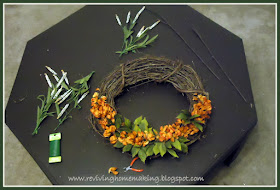Your front door is the first impression of your home and your personality. While some apartment buildings have uniquely styled exteriors, others are rather plain looking. Think about when you're looking at houses or being directed to a house. There are plenty of exterior elements in place to make it more appealing and to set it apart. I'm sure we've all been given the descriptions of "It's the house with (color) shutters" or something of the sort when given directions. An apartment can have that same effect! Your apartment is your home and it certainly doesn't have to be boring. Decorating the exterior gives it some excitement and helps guests easily find which unit is yours apart from all the other identical doors. Simply add a wreath to your door! Purchasing a pre-made wreath may be convenient, but it can also be rather pricey. A fun and affordable alternative is to create your own!
Materials can be shockingly expensive if not bought carefully. I purchased all my supplies either on sale or with a 40% off coupon (available online) from Hobby Lobby. To make the wreath you will need:
- 2 main floral stems (I chose orange)
- 2 secondary stems of a contrasting color to add interest (I chose cream)
- Grapevine wreath
- floral wire
- wire cutters (I used a tiny pair I have for jewelry)
- (Optional) Bow or letter to place at bottom (not pictured above but included in later pictures)
1. Cut stems into desired lengths. Lay out how you want the flowers to be arranged on the wreath before you begin.
2. Attaching the stems to the wreath by looping a piece of wire within the wreath and stem. Twist to secure in place. Cut the ends of the wire and tuck as much as possible out of sight. Aim to place the wires where leaves or flowers will easily hide them. If necessary, give them a little fluff to encourage them to do so.
3. Add your secondary stems. Separate the pieces if desired and begin adding them throughout the main flowers. Attach in the same manner as was done previously.
4. Optional- Attach a letter or bow to the center. I used the wire again, but you could also glue the letter to the wreath.
 Read Other Posts in the Home Sweet Apartment Series:
Read Other Posts in the Home Sweet Apartment Series:*Homemaking While Apartment Living: Part 1, Part 2
*Concepts For Small Space Living
Linked up at: Homemaker By Choice, A Mama's Story, An Original Belle, The Alabaster Jar, The Better Mom, Covered in Grace, Raising Arrows, Time-Warp Wife, Far Above Rubies, Growing Home, A Pause on the Path, Cornerstone Confessions
-*-*-*-*-*-*-*-*-*-*-*-*-*-*-*-*-*-*-*-*-*-*-*-*-*-*-*-
Visit the Reviving Homemaking Etsy Shop!


















